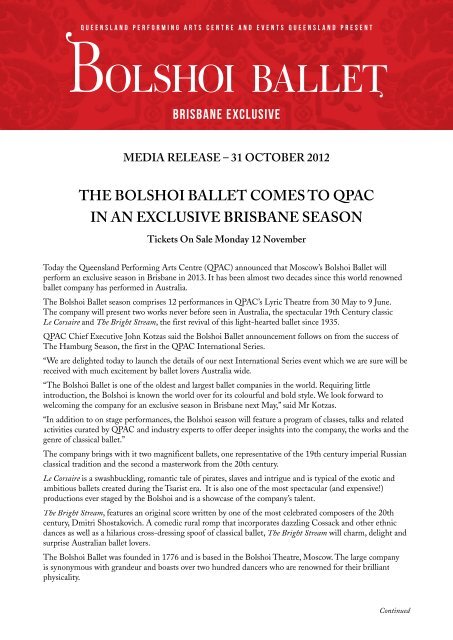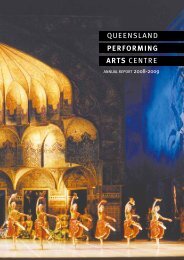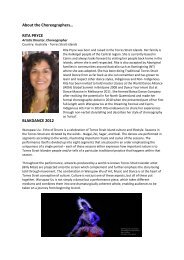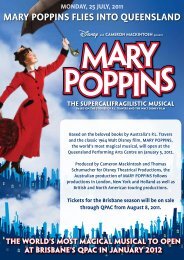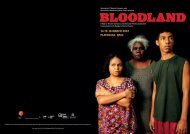Download - QPAC
Download - QPAC
Download - QPAC
You also want an ePaper? Increase the reach of your titles
YUMPU automatically turns print PDFs into web optimized ePapers that Google loves.
QUEENSLAND PERFORMING ARTS CENTRE AND EVENTS QUEENSLAND PRESENT<br />
BRISBANE EXCLUSIVE<br />
MEDIA RELEASE – 31 OCTOBER 2012<br />
THE BOLSHOI BALLET COMES TO <strong>QPAC</strong><br />
IN AN EXCLUSIVE BRISBANE SEASON<br />
Tickets On Sale Monday 12 November<br />
Today the Queensland Performing Arts Centre (<strong>QPAC</strong>) announced that Moscow’s Bolshoi Ballet will<br />
perform an exclusive season in Brisbane in 2013. It has been almost two decades since this world renowned<br />
ballet company has performed in Australia.<br />
The Bolshoi Ballet season comprises 12 performances in <strong>QPAC</strong>’s Lyric Theatre from 30 May to 9 June.<br />
The company will present two works never before seen in Australia, the spectacular 19th Century classic<br />
Le Corsaire and The Bright Stream, the first revival of this light-hearted ballet since 1935.<br />
<strong>QPAC</strong> Chief Executive John Kotzas said the Bolshoi Ballet announcement follows on from the success of<br />
The Hamburg Season, the first in the <strong>QPAC</strong> International Series.<br />
“We are delighted today to launch the details of our next International Series event which we are sure will be<br />
received with much excitement by ballet lovers Australia wide.<br />
“The Bolshoi Ballet is one of the oldest and largest ballet companies in the world. Requiring little<br />
introduction, the Bolshoi is known the world over for its colourful and bold style. We look forward to<br />
welcoming the company for an exclusive season in Brisbane next May,” said Mr Kotzas.<br />
“In addition to on stage performances, the Bolshoi season will feature a program of classes, talks and related<br />
activities curated by <strong>QPAC</strong> and industry experts to offer deeper insights into the company, the works and the<br />
genre of classical ballet.”<br />
The company brings with it two magnificent ballets, one representative of the 19th century imperial Russian<br />
classical tradition and the second a masterwork from the 20th century.<br />
Le Corsaire<br />
is a swashbuckling, romantic tale of pirates, slaves and intrigue and is typical of the exotic and<br />
ambitious ballets created during the Tsarist era. It is also one of the most spectacular (and expensive!)<br />
productions ever staged by the Bolshoi and is a showcase of the company’s talent.<br />
The Bright Stream, features an original score written by one of the most celebrated composers of the 20th<br />
century, Dmitri Shostakovich. A comedic rural romp that incorporates dazzling Cossack and other ethnic<br />
dances as well as a hilarious cross-dressing spoof of classical ballet, The Bright Stream will charm, delight and<br />
surprise Australian ballet lovers.<br />
The Bolshoi Ballet was founded in 1776 and is based in the Bolshoi Theatre, Moscow. The large company<br />
is synonymous with grandeur and boasts over two hundred dancers who are renowned for their brilliant<br />
physicality.<br />
Continued
In October 2011 the Bolshoi Theatre reopened after a six year renovation project costing over eight hundred<br />
million dollars. When the curtain went up the audience saw a brilliant new company with a renewed<br />
energy and sensational young talent. It was as if with this glittering scarlet and gold theatre, the physical<br />
embodiment of Russia’s cultural pride was born anew.<br />
The Bolshoi Ballet season is the second in the <strong>QPAC</strong> International Series, a joint initiative by <strong>QPAC</strong> and<br />
Events Queensland.<br />
To waitlist go to qpac.com.au or phone 136 246. Tickets on sale from Monday 12 November at 9.00am.<br />
Le Corsaire<br />
“The Bolshoi’s magnificent reconstruction of Le Corsaire by Yuri Burlaka and Alexei Ratmansky proved how<br />
exciting, compelling and artistically rewarding classical ballet can be! The dancing was divine.”<br />
Network Dance, USA<br />
The Bright Stream<br />
“Alexei Ratmansky has managed to produce a work nothing short of a masterpiece.”<br />
Dance Ballet Magazine, UK<br />
To download high resolution images and video footage please go to<br />
www.qpac.com.au/bolshoi/media-centre.html<br />
<strong>QPAC</strong> Publicity<br />
Cindy Ullrich, Publicity Manager, <strong>QPAC</strong> ~ 07 3840 7589 ~ cindy.ullrich@qpac.com.au<br />
or Inga Tracey, Publicity Coordinator, <strong>QPAC</strong> ~ 07 3840 7984 ~ inga.tracey@qpac.com.au<br />
For further media enquiries please contact:<br />
Bruce Pollack, National Publicist, The Bolshoi Season at <strong>QPAC</strong><br />
Telephone: (61 2) 9331 5276 Mobile: 0418 331 527 (61 418 331 527)<br />
Email: bruce@pollackconsulting.com
QUEENSLAND PERFORMING ARTS CENTRE AND EVENTS QUEENSLAND PRESENT<br />
BRISBANE EXCLUSIVE<br />
Season Details<br />
le corsaire<br />
Opening Night<br />
Thursday 30 May 7.00pm<br />
Friday 31 May 7.30pm<br />
Saturday 1 June 1.30pm & 7.30pm<br />
Sunday 2 June 3.00pm<br />
Tuesday 4 June 7.30pm<br />
Wednesday 5 June 1.30pm & 7.30pm<br />
the bright stream<br />
Opening Night<br />
Friday 7 June 7.30pm<br />
Saturday 8 June 1.30pm & 7.30pm<br />
Sunday 9 June 3.00pm<br />
FOR BOOKINGS AND TICKET PRICES GO TO<br />
<strong>QPAC</strong>.COM.AU OR PHONE 136 246
QUEENSLAND PERFORMING ARTS CENTRE AND EVENTS QUEENSLAND PRESENT<br />
BRISBANE EXCLUSIVE<br />
The Bolshoi Ballet:<br />
big bravura dancing<br />
Written by Dr Michelle Potter<br />
When an ensemble of dancers from Moscow’s Bolshoi Ballet visited Australia in 1959 they caused a<br />
sensation. It was the first time dancers from the Bolshoi had been seen in Australia and patrons queued<br />
for hours to buy tickets or to secure standing room. Every night when the curtain went up audiences were<br />
astonished by the strength and athleticism of the dancers and by the intensity and emotional power they<br />
brought to the stage. A reputation for explosive, dramatic dancing preceded them, and they more than<br />
lived up to it. The men covered the stage with huge jumps. The women seemed to fly as they were tossed<br />
high in the air by their partners. It was big, bravura dancing and unlike anything that had been seen in<br />
Australia before.<br />
Origins<br />
The Bolshoi Ballet can trace its history back to 1776 with the formation of a private company of actors<br />
and dancers whose style of performance mixed folk dancing, mime and drama. But it was not until artists<br />
following in the footsteps of this early group, and using the same repertoire and performance style, began<br />
performing in Moscow’s New Bolshoi Petrovsky Theatre in the 1820s that the name Bolshoi (meaning big)<br />
was used to describe the company.<br />
From small beginnings the Bolshoi Ballet has come to be recognised as one of the great ballet companies<br />
of the world. A major cultural export for Russia since the 1950s, the company has brought to world-wide<br />
attention a galaxy of exceptional performers: Galina Ulanova, Maya Plisetskaya, Nikolai Fadeyechev,<br />
Ekaterina Maximova, Vladimir Va siliev, Natalia Bessmertnova, Irek Mukhamedov, Nina Ananiashvili and<br />
Andris Liepa and many others.<br />
A changing company<br />
The Bolshoi Ballet has undergone periods of dramatic change over the centuries and for the most part these<br />
changes reflect different social and political conditions. At the end of the nineteenth century the Bolshoi<br />
Ballet appeared to take second place to the ballet company located in St Petersburg. This company enjoyed<br />
the patronage of the Tsar’s court and its style of dancing was different. Moscow had its dramatic legacy while<br />
St Petersburg had a greater focus on pure dance.<br />
Following the October Revolution of 1917, however, the seat of power and patronage moved to Moscow as<br />
the capital of the Soviet Union and, although there were some specific exceptions, ballet was accepted by the<br />
Kremlin as an art form suitable for the new regime. Moreover, the Bolshoi Ballet had appointed a new ballet<br />
director in 1900, Alexander Gorsky. Gorsky and his successor, Vladimir Tikhomirov, appointed in 1924, were<br />
able to consolidate the company’s dramatic style and incorporate Communist ideology into the company’s<br />
works. A new form of ballet for the people developed, exemplified by The Red Poppy in 1927.<br />
Continued
During World War II the Bolshoi company was evacuated to Kuibyshev on the Volga. On the company’s<br />
return to Moscow, renowned dancer Galina Ulanova and choreographer and director Leonid Lavrovsky<br />
moved from St Petersburg to join the Bolshoi Ballet. Post war revitalisation of the company began. Under<br />
Lavrovsky the company made its first appearances in the West, beginning in London in 1956, followed by a<br />
major season in New York and then by the momentous Australian visit of 1959.<br />
Lavrovsky was succeeded by Yuri Grigorovich in 1964 and under his direction the Bolshoi Ballet performed<br />
large scale, spectacular ballets including a version of Spartacus in 1968, Ivan the Terrible in 1975 and<br />
The Golden Age in 1982. Grigorovich also presided over major productions of nineteenth-century classics<br />
including Swan Lake, La Bayadère, Le Corsaire and Raymonda. They were all epic productions on the<br />
grandest of scales.<br />
Into the twenty-first century<br />
A series of ballet directors followed Grigorovich. Perhaps the biggest change of all, however, came in<br />
2004 when Alexei Ratmansky was named artistic director of the Bolshoi Ballet. Ratmansky had trained<br />
in Moscow before dancing with several major Western ballet companies. He came to the Bolshoi with a<br />
growing reputation as a choreographer skilled in creating new versions of old works. For the Bolshoi Ballet<br />
he remade early Soviet works from the repertoire including The Bright Stream in 2003 and The Bolt in 2005<br />
and restaged the nineteenth-century ballet Le Corsaire in 2007 and the Soviet-era Flames of Paris in 2008.<br />
He also introduced into the Bolshoi Ballet the work of contemporary choreographers from the West,<br />
including ballets by George Balanchine, Twyla Tharp and Christopher Wheeldon.<br />
Under Ratmansky’s directorship a major rejuvenation of the company took place and the Bolshoi Ballet<br />
received many accolades for its performances in Russia, England and the United States. Ratmansky left<br />
the Bolshoi Ballet in 2008 and his shoes were filled first by Yuri Burlaka in 2009 and then by Sergei Filin<br />
in 2011.<br />
Now in 2013 the Bolshoi Ballet is still dancing with that big, bravura style that Australians saw in 1959<br />
and on several subsequent visits. Its dancers are still exuberant performers and, in addition to reflecting a<br />
chequered but distinctive history, the Bolshoi Ballet’s repertoire is still spectacularly entertaining.<br />
Not to be copied or reproduced.
QUEENSLAND PERFORMING ARTS CENTRE AND EVENTS QUEENSLAND PRESENT<br />
BRISBANE EXCLUSIVE<br />
Adolphe Adam<br />
Le Corsaire<br />
Ballet in three acts<br />
Creative Credits<br />
Premiered on June 21, 2007.<br />
Presented with two intervals.<br />
Running time: 3 hours<br />
35 minutes.<br />
Libretto by Jules Henri Vernoy de Saint-Georges<br />
and Joseph Mazilier edited by Marius Petipa<br />
Choreography: Marius Petipa<br />
Revival: Alexei Ratmansky, Yuri Burlaka<br />
New Choreography: Alexei Ratmansky<br />
Designer: Boris Kaminsky<br />
Costume Designer: Elena Zaitseva<br />
Music Director: Pavel Klinichev<br />
Lighting Designer: Damir Ismagilov<br />
Use is made in the production of music by Leo Delibes, Cesare Pugni,<br />
Pyotr von Oldenburg, Riccardo Drigo, Albert Zabel, Julius Gerber.<br />
Music dramaturgy conception — Yuri Burlaka<br />
Score restored by Alexander Troitsky<br />
The original score by Adolphe Adam/Leo Delibes for Le Corsaire has<br />
been made available by L’Opera national de Paris from the archives of<br />
La Bibliotheque nationale de France<br />
The choreographic notation has been made available by the Harvard<br />
University Theatre Collection<br />
Evgeny Ponomaryov’s costume sketches (1899) used in the production have<br />
been made available by the St. Petersburg State Theatre Library<br />
© 2000–2011 The State Academic Bolshoi Theatre of Russia
QUEENSLAND PERFORMING ARTS CENTRE AND EVENTS QUEENSLAND PRESENT<br />
BRISBANE EXCLUSIVE<br />
Le Corsaire<br />
Background<br />
Written by Valerie Lawson.<br />
Long before the age of Hollywood blockbusters, a French choreographer conceived the balletic equivalent<br />
with the spectacular Le Corsaire.<br />
The guests of honour at the premiere in Paris were Napoleon III and Empress Eugénie. When the ballet<br />
ended, the empress, a balletomane, was so entranced that she told the director of the Théâtre Impérial de<br />
l’Opéra: “I have never in my life and probably will shall never see again anything at once so beautiful and so<br />
moving”.<br />
And, she might have added, so packed with melodramatic love triangles, so many conflicts between the naïve,<br />
the good, the greedy, and the just plain evil, and a storm on stage that surpasses The Tempest.<br />
With its slave girls and pirates, its costumes of gold, turquoise, cobalt and orange, and its postcard settings at<br />
a bazaar, a cave, a seraglio, and at sea, Le Corsaire could well have inspired a swashbuckling pirate movie, from<br />
Captain Blood, starring Errol Flynn, to Johnny Depp’s Pirates of the Caribbean.<br />
But its origins lay in the 19 th century when ballets were often set in exotic locations, far from Paris – such as<br />
La Sylphide, with its Scottish setting, La Bayadere in India and Le Corsaire in Turkey. In each of these three<br />
ballets, the appearance and costumes of the locals – kilts, harem pants, turbans, or Greek skirts and boots, are<br />
incongruously paired with the classical ballet attire of tights, tutus and pointe shoes.<br />
Le Corsaire is one of the very few ballets from the mid-19 th century that is still performed today. But its<br />
longevity is not due to the story or the settings, but to the choreographic complexity, the elegance of its<br />
tableaux, and to its bravura solos, pas de deux and ensembles - all danced to the music of no less than seven<br />
composers, Adolphe Adam, Cesare Pugni, Leo Delibes, Riccardo Drigo, Pyotr von Oldenburg, Albert Zabel<br />
and Julius Gerber.<br />
The rollcall of composers is indicative of the ballet’s past. Le Corsaire premiered in France in 1856 but soon<br />
after became linked to the history of ballet in Russia, joining the select ranks of the grand classical ballets<br />
created in the 19 th century in either Moscow or St Petersburg, among them Don Quixote, Le Bayadere,<br />
Nutcracker, The Sleeping Beauty and Swan Lake.<br />
Le Corsaire was revived and restored so many times that it became a mosaic of design, choreography and score<br />
– from the production by Jules Perrot at the Bolshoi Theatre in Moscow, to Marius Petipa’s reinterpretations,<br />
including his version of 1868 when he added the deliciously romantic scene, Le Jardin Animé, and finally to<br />
Petipa’s major new production in 1899 on which all subsequent rev isions are based.<br />
By the close of the 19 th century, the work of the ballet’s original French choreographer, Joseph Mazilier, and<br />
its composer, Adolphe Adam, had all but vanished as had any tenuous connection with the inspiration for the<br />
ballet, Byron’s poem of 1814, The Corsair.<br />
Continued
Throughout the 20 th century the ballet’s home remained Russia with the companies in the West more likely<br />
to stage Corsaire excerpts such as the showy pas de deux danced by Margot Fonteyn and Rudolf Nureyev as<br />
Ali, the slave to the pirate, Conrad. The partnership of Fonteyn-Nureyev riveted audiences with the contrast<br />
between her serene beauty and his panther-like athleticism.<br />
For the Bolshoi’s present production, premiering in 2007, the choreographer, Alexei Ratmansky and the<br />
ballet master and dance reconstruction specialist, Yuri Burlaka, researched dance, design and music archives<br />
in Moscow, St Petersburg and Paris to create a Corsaire that honours Petipa’s 1899 version in choreography<br />
and décor, with the addition of Ratmansky’s own choreography.<br />
The settings, by Boris Kaminsky, suggest a 19 th century European artist’s interpretation of the exotic middle<br />
east, from the opening scene in a bazaar square in the Turkish city of Adrianople to the final tableau, recalling<br />
the romantic shipwreck paintings of Turner.<br />
Of course none of this would matter if Le Corsaire did not enchant with the dancing itself and with the<br />
two principal roles of Medora, a young Greek woman who becomes a slave to Pasha Seyd, and Conrad, her<br />
rescuer and lover.<br />
The role of Medora has been danced by many famous ballerinas, among them Anna Pavlova, Tamara<br />
Karsavina and Olga Preobrajenska, with the current generation of Bolshoi Ballet principals now excelling<br />
in both the interpretation of the heroine, and the technical skills requiring extraordinary stamina due to the<br />
length of the ballet itself as well as for her leaps and rapid turns.<br />
Conrad, a mime role in the original French production, is just as much a showcase for virtuoso male dancers<br />
whose ranks have included the Bolshoi Ballet’s artistic director, Sergei Filin, who danced the role during the<br />
Bolshoi Ballet’s tour of London in 2007.<br />
The choreographic jewel in the Corsaire crown is Le Jardin Animé in which an array of white tutu’d dancers<br />
form shapes and patterns suggesting a formal garden of flowers. Their hair and bodices are adorned with<br />
pink roses, and they hold single stems, bouquets, baskets of flowers and garlands.<br />
The scene is a ballet lover’s delight. Danced to Delibes’s waltz from the ballet, La source, ou Naila, it has<br />
nothing to do with the complex plot of Le Corsaire and everything to do with grand spectacle.<br />
As indulgent as whipped cream, Le Jardin Animé is also a meditation, reminiscent of classical ballet’s most<br />
sublime moments in which the ballerina presides over her ensemble - the swans at the lake, the shades of<br />
La Bayadere, the Wilis of Giselle, and the dryads in the dream scene of Don Quixote.<br />
Le Jardin Animé has been called “femininity as horticulture, an idea that should be offensive to a modern<br />
mind enlightened by feminism but ravishing here nonetheless”.<br />
It’s also escapism itself, and escapism in this class is one reason we go to the ballet, to abandon all logical<br />
thought, and simply indulge in a feast of dancing.<br />
Not to be copied or reproduced.
QUEENSLAND PERFORMING ARTS CENTRE AND EVENTS QUEENSLAND PRESENT<br />
BRISBANE EXCLUSIVE<br />
Le Corsaire<br />
CAST LIST<br />
30 May to 5 June, Lyric Theatre, <strong>QPAC</strong><br />
Subject to change.<br />
Medora<br />
Conrad<br />
Gulnare<br />
Birbanto<br />
Pas d’esclaves<br />
Lanquedem<br />
Seyd, the Pasha<br />
Zulmea<br />
Keeper of Seyd, the Pasha’s harem<br />
Eunuchs<br />
Danse des forbans Soloists<br />
Danse des forbans<br />
A Negress<br />
A Mufti<br />
Maria Alexandrova<br />
Ekaterina Shipulina<br />
Ekaterina Krysanova<br />
Vladislav Lantratov<br />
Ruslan Skvortsov<br />
Mikhail Lobukhin<br />
Nina Kaptsova<br />
Kristina Kretova<br />
Andrey Merkriev<br />
Denis Savin<br />
Anna Tikhomirova<br />
Denis Medvedev<br />
Chinara Alisade<br />
Andrey Bolotin<br />
Kristina Kretova<br />
Egor Simachev<br />
Alexey Loparevich<br />
Maria Zharkova<br />
Ilya Vorontsov<br />
Alexander Petukhov<br />
Sergey Minakov<br />
Anna Antropova<br />
Anastasia Meskova<br />
Anna Balukova<br />
Anna Balukova<br />
Anastasia Meskova<br />
Anna Antropova<br />
Eugene Golovin<br />
Anton Savichev<br />
Alexander Vodopetov<br />
Anastasia Vinokur<br />
Alexander Fadeechev<br />
Continued
Pas des trois Odalisques Maria Vinogradova<br />
Julia Grebenshikova<br />
Anna Tikhomirova<br />
Chinara Alisade<br />
Le Jardin Anime<br />
2 soloists Chinara Alisade<br />
Julia Lunkina<br />
Daria Khokhlova<br />
6 soloists Svetlana Pavlova<br />
Daria Khokhlova<br />
Alesya Gradova<br />
Joo Yun Bae<br />
Julia Lunkina<br />
Gnedova Svetlana<br />
Grand pas des eventailles<br />
Soloist<br />
Pas des eventails<br />
Ruslan Skvortsov<br />
Vladislav Lantratov<br />
Mikhail Lobukhin<br />
Svetlana Pavlova<br />
Julia Lunkina<br />
Voronkova Anna<br />
Svetlana Gnedova<br />
Alesya Gradova<br />
Joo Yun Bae<br />
12 corsairs Batyr Annadurdyev<br />
Alexander Vodopetov<br />
Appolinary Proskurnin<br />
Eugeny Golovin<br />
Dmitry Starshinov<br />
Alexey Tedeev<br />
Anton Savichev<br />
Ivan Semirechenskiy<br />
Victor Kleyn<br />
Egor Khromushin<br />
Maxim Oppengeym<br />
Dmitry Dorokhov<br />
Maxim Surov<br />
Denis Savin
QUEENSLAND PERFORMING ARTS CENTRE AND EVENTS QUEENSLAND PRESENT<br />
BRISBANE EXCLUSIVE<br />
Adolphe Adam<br />
Le Corsaire<br />
Ballet in three acts<br />
Synopsis<br />
Act I Scene 1<br />
Medora is Kidnapped<br />
The bazaar square. The beautiful slave-girls who are up for sale, sit awaiting buyers; here too throngs a crowd<br />
of Turks, Greeks and Armenians who are examining the wares brought from all corners of the earth.<br />
A band of corsairs appear in the square, led by Conrad. He has evidently come to the bazaar to carry out his<br />
secret plan to meet a certain beautiful stranger.<br />
Medora, the ward of bazaar-owner Isaac Lanquedem, comes out on to the balcony of her guardian’s house.<br />
Seeing Conrad, she quickly makes a selam* out of the flowers she has to hand and throws it to him. The<br />
latter, reading the selam is delighted, because now he is convinced the beautiful Medora loves him.<br />
Isaac and Medora appear in the square. While Isaac examines the slave-girls, Medora and Conrad exchange<br />
passionate and meaningful glances.<br />
A rich buyer appears in the square — Seyd-Pasha — and his suite. He is surrounded by dealers showing off<br />
their girls, but not one of the latter pleases the Pasha. Then Seyd-Pasha catches sight of Medora. He decides<br />
come what may to purchase her but Isaac refuses to sell him his ward, obsequiously explaining to Seyd-Pasha<br />
that she is not for sale and offering him instead a pair of other maidens.<br />
But Seyd-Pasha insists on buying Medora. His offers are so advantageous and attractive that Isaac is unable<br />
to resist them and agrees to the deal. Issuing an order that the new slave-girl he has just bought be delivered<br />
to his harem, Seyd-Pasha goes off, threatening Isaac with punishment if Medora is not immediately<br />
dispatched to his harem. Conrad calms down Medora, promising that the corsairs will kidnap her.<br />
At a sign from Conrad, the corsairs start a merry dance with the slave-girls, in which Medora takes an active<br />
part, to the great delight of all present. But suddenly, Conrad gives the signal, and the corsairs make off with<br />
the slave-girls and Medora too. Isaac runs after Medora and tries to snatch her from the corsairs; Conrad<br />
orders that Isaac, who is frightened out of his wits, should also be seized.<br />
Continued
Scene 2<br />
The Plotters<br />
The corsairs’ den. The corsairs, with their rich booty and captive maidens return to their lair; also brought<br />
here is the trembling Isaac. Medora, saddened by the fate of her fellow slaves, begs Conrad to free them<br />
and he agrees. Birbanto and the other pirates protest, saying that they too have a right to the women. They<br />
become mutinous. Conrad, deflecting a blow aimed at him, forces Birbanto to his knees; then he soothes a<br />
frightened Medora and carefully protecting her, goes through with her into the tent.<br />
Taking advantage of the general confusion, Isaac decides to make his escape. However he is seen by Birbanto<br />
and the other pirates who taunt him and, taking all his money, suggest that he participate in a plot to get<br />
back Medora. Picking a flower from the bunch, Birbanto sprays it with a sleeping potion, he then hands it to<br />
Isaac and tells him to give it to Conrad.<br />
Conrad appears and arranges for dinner to be served. While the corsairs are having their supper, Medora<br />
dances for Conrad who swears eternal love to her.<br />
Gradually the corsairs disperse, except for Birbanto and several of his henchmen who are keeping an eye on<br />
Conrad and Medora. Isaac now appears with a young slave-girl; pointing to Medora, he tells the slave-girl<br />
to give her the flower. Medora, clasps the flower to her breast and hands it to Conrad, adding that flowers<br />
explain all her love for him. Conrad, lovingly presses the flower to his lips but the intoxicating smell goes to<br />
his head and, despite his incredible efforts not to succumb to its effect, he immediately falls into a deep sleep.<br />
Birbanto makes a sign to the plotters to put their plan into action.<br />
Medora is taken aback at Conrad suddenly falling asleep. She is surrounded by the corsairs who threaten her.<br />
Trying to defend herself, Medora stabs Birbanto in the arm and, attempting to flee, she faints and falls into<br />
the arms of her kidnappers.<br />
Dismissing his henchmen, Birbanto is about to make short work of Conrad when the latter wakes up.<br />
Hearing that Medora has been abducted, Conrad and the corsairs set off in pursuit.<br />
Act II Scene 3<br />
The Corsair’s Captive<br />
Seyd-Pasha’s palace. The bored odalisques start playing various games. Zulma demands that the odalisques<br />
show her respect, but Gulnare and her friends mock the haughty sultana.<br />
Enter Seyd-Pasha. The odalisques are required to bow down before their master, but the unruly Gulnare<br />
mocks him too. Seyd-Pasha, carried away by her youth and beauty, throws her his handkerchief, but Gulnare<br />
throws it on to her friends, eventually the handkerchief, passing from hand to hand, reaches an old negress<br />
who, picking it up, starts to chase Seyd-Pasha, smothering him with her caresses. Seyd-Pasha is hard put to it<br />
to contain his anger.<br />
In an attempt to please the Pasha, the Keeper of the harem brings forward three odalisques. Zulma tries to<br />
attract the Pasha’s attention but, at that moment, the latter is told of the arrival of the slave trader.<br />
Catching sight of Isaac, who leads in Medora, Seyd-Pasha is overjoyed. Medora begs Seyd-Pasha to grant<br />
her her freedom but, seeing that he is unrelenting, complains of cruel treatment by her guardian; Seyd-Pasha<br />
orders the eunuch to send the Jew packing. Going up to Medora, Gulnare is kind to her and sympathizes<br />
with her lot. Seyd-Pasha offers Medora various jewels but, to Seyd-Pasha’s displeasure and Gulnare’s joy, she<br />
turns them down outright.<br />
The leader of a group of dervishes appears, who requests lodging for the night. Seyd-Pasha permits the<br />
dervishes to put up in his garden. Amused at the dervishes’ embarrassment at the sight of the young,<br />
seductive slave-girls, Seyd-Pasha promises to acquaint them with all the delights his harem has to offer and<br />
orders the slave-girls to start dancing.<br />
Among the beautiful dancing girls, Conrad recognizes his beloved.<br />
Continued
At the end of the celebration, Seyd-Pasha orders that Medora be conducted to his private rooms in the<br />
palace. Throwing off their dervish disguise, the corsairs threaten Seyd-Pasha with their daggers; Conrad and<br />
Medora embrace.<br />
The corsairs are engrossed in their plundering of Seyd-Pasha’s palace. Gulnare comes running in, pursued by<br />
Birbanto, she rushes up to Medora and begs for her help. Conrad takes Gulnare’s part, meanwhile Medora<br />
recognizes Birbanto as her kidnapper and informs Conrad of his treacherous action. Laughing, Birbanto<br />
denies her accusation; in confirmation of her words, Medora points out to Conrad the wound she inflicted on<br />
Birbanto by stabbing him in the arm. Conrad is about to shoot the traitor, but Medora and Gulnare restrain<br />
him and Birbanto runs off shouting threats.<br />
Medora, giddy with weakness and nervous tension, is on the point of fainting but, with assistance from<br />
Gulnare and Conrad, she regains consciousness and, at their request, is about to follow them when, suddenly,<br />
Seyd-Pasha’s guards burst into the hall. The corsairs are routed, Conrad is disarmed and sentenced to death.<br />
Seyd-Pasha is victorious.<br />
Act III Scene 4<br />
Seyd-Pasha’s wedding<br />
Seyd-Pasha’s private rooms in the palace. Seyd-Pasha gives orders that preparations get underway for his<br />
wedding to Medora. He proposes to Medora who indignantly turns him down. Conrad in chains is led<br />
to his execution. Medora, seeing the terrible plight of her loved one, begs Seyd-Pasha to show him mercy.<br />
Seyd-Pasha promises to pardon Conrad on the condition that Medora, of her own free will, agrees to be his.<br />
Medora is at her wit’s end and, in despair, she accepts Seyd-Pasha’s terms.<br />
Left on their own, Conrad hurries over to Medora who tells him on what condition Seyd-Pasha has agreed<br />
to free him. Conrad rejects the nefarious condition and they decide to die together. Gulnare who has been<br />
observing them suggests a plan; the lovers agree to it and thank her profusely.<br />
Seyd-Pasha returns. Medora informs him she accepts his terms. Overjoyed, Seyd-Pasha gives orders that<br />
Conrad be freed from all form of persecution and that preparations be put in hand for the wedding ceremony.<br />
The wedding procession approaches, the bride is covered by a veil. At the end of the ceremony, Seyd-Pasha<br />
gives the bride his arm, and puts a ring on her finger. The dances of the odalisques bring the wedding to<br />
an end.<br />
Left alone with Seyd-Pasha Medora tries to entice him with her dances, but it is quite obvious that she can’t<br />
wait for the hour of her delivery. Catching sight of the pistol in Seyd-Pasha’s belt, she says it frightens her<br />
and asks him to take it off. Seyd-Pasha does as he is asked and hands the pistol to Medora. Her fear increases<br />
at the sight of the dagger, also tucked in his belt. To calm her down once and for all, Seyd-Pasha pulls the<br />
dagger free and gives it to her. He then tries to embrace her but, dancing, Medora slips nimbly from his<br />
grasp. Seyd-Pasha falls at her feet and, imploring her love, gives her his handkerchief. As if for a joke, she<br />
ties his hands up with it and he, amused, laughs at her prank. On the stroke of midnight, Conrad appears.<br />
Seyd-Pasha is horrified when he sees Medora hand over his dagger to Conrad; he wants to call for help<br />
but Medora aims the pistol at him and says she will kill him if he so much as opens his mouth. Seyd-Pasha<br />
doesn’t dare utter a word, meanwhile Medor and Conrad quickly escape.<br />
Seyd-Pasha tries to free himself. Gulnare comes running in and, feigning horror, unties his hands. Seyd-<br />
Pasha summons his guard and orders them to pursue the fugitives. Three shots of the cannon bring the news<br />
that the corsairs’ ship has set sail. Seyd-Pasha has a violent fit of temper: his beloved wife has been abducted.<br />
“I’m your wife”, says Gulnare, and, pointing to her wedding finger she adds, “This is your ring!” Seyd-Pasha<br />
is left in a state of shock.
Scene 5<br />
Storm and Shipwreck<br />
At sea. A clear and peaceful night on deck. The corsairs are celebrating their liberation. Only the hapless<br />
Birbanto, in chains, does not take part in the merry-making. Taking pity on him, Medora asks Conrad<br />
to forgive Birbanto and the latter joins in her pleas. After some hesitation Conrad pardons Birbanto who<br />
requests permission to regale his fellow pirates with a barrel of wine.<br />
There is a swift change in the weather and a storm gets up; taking advantage of the confusion, Birbanto again<br />
starts to stir up trouble with the pirates, but Conrad throws him overboard. The storm gets worse: there are<br />
peals of thunder, flashes of lightning and a very rough sea. A resounding crack is heard and the ship goes<br />
aground on a rock.<br />
The wind slowly dies down and the sea becomes calm again. The moon comes out and two figures are lit up<br />
in its silvery light: these are Medora and Conrad who, miraculously, haven’t drowned. They reach the rock,<br />
clamber up onto it and thank God for their salvation.<br />
*Selam — bouquet in which each flower has special meaning. The language of flowers and communication<br />
by means of a ‘flower code’ was very popular in Europe at the end of the 18-19 centuries.<br />
© 2000–2011 The State Academic Bolshoi Theatre of Russia
QUEENSLAND PERFORMING ARTS CENTRE AND EVENTS QUEENSLAND PRESENT<br />
BRISBANE EXCLUSIVE<br />
The Bolshoi Ballet:<br />
the famous pas de deux<br />
Written by Valerie Lawson<br />
The pas de deux in Le Corsaire is one of the most famous moments in the classical ballet repertoire, yet it’s<br />
confusingly mysterious in its origins and many interpretations.<br />
From 1962, Rudolf Nureyev and Margot Fonteyn entranced audiences when they danced the showcase<br />
pas de deux, with Nureyev as Ali, the bare chested, panther-like slave, and Fonteyn as Medora, his beloved.<br />
The final pose, with Nureyev reclining on the floor, gazing at Fonteyn in adoration, said it all about their<br />
May-December partnership on stage, and possibly off stage.<br />
The male variation that forms part of the pas de deux is only a minute long, yet, with its multiple pirouettes,<br />
tucked-leg jumps and machismo poses it remains one of the most impressive and commonly performed solos<br />
at ballet competitions worldwide.<br />
The pas de deux – danced in the second scene of Act One – was a latecomer to Le Corsaire. The ballet was<br />
first choreographed by Joseph Mazilier in 1866 in Paris, and adapted by Jules Perrot two years later in Russia.<br />
But dance historians believe that the pas de deux made its first appearance in 1899 when Marius Petipa<br />
staged the final version of his many productions of the ballet in St Petersburg.<br />
More recent research suggests that the pas de deux was first danced in 1915, when the ballet master,<br />
Samuil Andrianov, staged a production at the Mariinsky Theatre, St Petersburg.<br />
Just to add more confusion, this interpolated dance was really a ‘pas de deux à trois’ for Medora, Conrad,<br />
the pirate, and a second suitor, who had danced in the Pas d’Esclave (Slave Dance) in the first scene of Act I.<br />
However, the slave was unnamed until the Soviet era. The cast list for a production staged in Russia by<br />
Agrippina Vaganova in 1936 shows him as “Rhab”.<br />
In 1955, for a new version of the ballet for the Maly Theatre Ballet in St Petersburg, the slave became “Ali”.<br />
Over time, only Ali danced the pas de deux with Medora and it was this version that Nureyev brought to the<br />
West after he defected from the Soviet Union in 1961.<br />
For his revival of Le Corsaire for the Bolshoi Ballet in 2007 Alexei Ratmansky has gone back to Petipa’s 1899<br />
production but there is no Ali. The pas de deux is danced by Medora and Conrad in the setting of a grotto,<br />
the den of the pirates.<br />
No matter how it is staged, the pas de deux always retains its wow factor as one of the major highlights of<br />
Le Corsaire.<br />
Not to be copied or reproduced.
QUEENSLAND PERFORMING ARTS CENTRE AND EVENTS QUEENSLAND PRESENT<br />
BRISBANE EXCLUSIVE<br />
Dmitry Shostakovich<br />
The Bright Stream<br />
Comic ballet in two acts<br />
Creative Credits<br />
Premiered on April 18, 2003.<br />
Presented with one interval.<br />
Running time: 2 hours 5<br />
minutes.<br />
Libretto by Adrian Piotrovsky and Fyodor Lopukhov<br />
Choreographer: Alexei Ratmansky<br />
Designer: Boris Messerer<br />
Music Director: Pavel Sorokin<br />
Lighting Designer: Alexander Rubtsov<br />
© 2000–2011 The State Academic Bolshoi Theatre of Russia
QUEENSLAND PERFORMING ARTS CENTRE AND EVENTS QUEENSLAND PRESENT<br />
BRISBANE EXCLUSIVE<br />
The Bright Stream<br />
Background<br />
Written by Valerie Lawson.<br />
Dancing farmers, a tractor driver, a man on a bicycle dressed as a dog and another in drag as a sylph in pointe<br />
shoes, all cavorting against a backdrop of golden sheaves of wheat on a collective farm.<br />
How could these be among the cast of characters in The Bright Stream, a ballet that first arose under the<br />
tyrannical leadership of Joseph Stalin?<br />
The transformation of this Soviet-era ballet of the 1930s into a joyous and comic ballet that has charmed<br />
audiences in Moscow, London and New York in the last decade is all due to one man, the acclaimed<br />
choreographer, Alexei Ratmansky.<br />
Born in St Petersburg and trained as a dancer in Moscow, Ratmansky is steeped in the history of Russian<br />
ballet and the work of Russian composers, and in particular, Dimitri Shostakovich. So in 1995 when he first<br />
heard the composer’s score for a long forgotten ballet, called The Limpid Stream, he was entranced.<br />
“It sounded incredible”, he said. “I couldn’t believe that no one had returned to it before. The music is just<br />
so danceable, with this wonderful variety of adagios, waltzes and polkas. It’s like [Ludwig] Minkus but all on<br />
the level of Shostakovich’s genius”.<br />
The choreographic notation of the 1935 ballet was nowhere to be found. But in 2003, using the original<br />
libretto and music, Ratmansky staged his reconstruction of the original Limpid Stream for the Bolshoi Ballet<br />
in Moscow.<br />
Renamed The Bright Stream, the ballet is set at a harvest festival at a collective farm in the north of Russia,<br />
complete with happy workers intermingling with a visiting troupe of ballet dancers from the city.<br />
Ballets featuring festival celebrations are not uncommon, (Coppelia, Flower Festival at Gennaro, for example),<br />
but a collective farm festival was an extremely radical and in retrospect, a dangerous idea in the 1930s – even<br />
though the creators of The Limpid Stream – the librettist, Adrian Piotrovsky, the choreographer, Fyodor<br />
Lopokov and the composer, Shostakovich - had no idea at the time of the terrible outcome of Stalin’s<br />
collective farm project. The forced confiscation of individually owned private farms, an era known as “the<br />
second serfdom”, led to the exile or death of many farmers who resisted.<br />
With its witty scenario and danceable score, The Limpid Stream was a critical success when it premiered at<br />
the Maly Theatre in Leningrad. As Ratmansky recalled: “All the critics raved about new horizons opening up<br />
and about this being the first major success of Soviet ballet”.<br />
But in January 1936, when the ballet transferred to the Bolshoi Theatre in Moscow, the edifice came<br />
crumbling down on their heads.<br />
Continued
An editorial in Pravda labelled it a “balletic fraud”, with its depiction of socialist peasants as “sugary paysans<br />
from a pre-revolutionary chocolate box”.<br />
As Judith Mackrell wrote in her biography of the ballerina, Lydia Lopokova, sister of Fyodor Lopokov, “the<br />
only artistic crime apparently committed [by the choreographer and librettist] was to put the ballet’s cast of<br />
farmworkers in pointe shoes, and to show them performing classical steps rather than ‘local folk dances and<br />
games’; yet as a result, the librettist, Adrian Piotrovsky was sent to the gulag (from which he never returned)”.<br />
Even before the premiere of The Limpid Stream, Shostakovich was out of favour with Stalin who hated his<br />
Lady Macbeth of Mtsensk, an opera ridiculed by the newspaper, Pravda, as a “confused stream of sound”<br />
filled with “quacks, grunts, and growls”. Just one week after this denunciation, Pravda went in for the kill,<br />
describing the score for The Limpid Stream as “music without character”. Shostakovich never wrote another<br />
ballet score.<br />
As for Lopokov, newly promoted as director of the Bolshoi Ballet, he was stripped from the role and his<br />
career almost came to an end.<br />
Many years later, Ratmansky’s rescue of Lopokov’s reputati on was an important factor in his recreation of the<br />
ballet and it’s easy to see him as a successor to Lopokov in his love of narrative, his fascination with Russian<br />
history and social life, and his love of the work of Shostakovich.<br />
Asked by The New York Times what draws him to the music of Shostakovich, Ratmansky said: “He’s very<br />
Russian. You can learn the history of the country from his music. He was very sensitive, very true, even if he<br />
had to have a mask on. Like Dostoyevsky and Tolstoy, on that level of diving deep into the soul and the time.<br />
His music answers so many questions.<br />
“He was the child of the Russian avant-garde, super brave and grotesque, almost evil. And then in the ’30s he<br />
went through such pressure, it crushed his self-importance. He expected arrest every night. His friends and<br />
relatives were arrested and killed. It changed his ideas of what the artist should be”.<br />
Although Ratmansky has been artist-in-residence at American Ballet Theatre in New York since 2008, his<br />
choreography continues to honour the legacy of his Russian predecessors, such as Leonide Massine, who<br />
danced at the Bolshoi before joining Diaghilev’s Ballets Russes where he carried on the Bolshoi traditions<br />
of character dancing, mime, and comedy in ballets such as Gaité Parisienne and Scuola di ballo (the last rechoreographed<br />
by Ratmansky for The Australian Ballet in 2009).<br />
The Bright Stream, in particular, is built around character and demi-character roles of the kind that enlivened<br />
the ballets of the English choreographers, John Cranko and Frederick Ashton.<br />
Just as Ashton’s Cinderella features men in drag as the Ugly Stepsisters, and the ladies of Portsmouth in<br />
Cranko’s Pineapple Poll disguise themselves as sailors to go searching for desirable captain of HMS Hot<br />
Cross Bun, Ratmansky’s Bright Stream features cross dressing, a tangled web of confused identities, and a<br />
semi-farcical plot as complex as The Marriage of Figaro and A Midsummer Night’s Dream.<br />
The story unfolds against Boris Messerer’s sets of harvest produce and wheat with the ballet’s colourful<br />
array of roles including an accordion player who chases a schoolgirl, Zina, the entertainment director of<br />
the collective farm, called The Bright Stream, Zina’s husband, Pyotr, an agricultural student enchanted by<br />
the visiting Ballerina, her partner, the Ballet Dancer, and an Old Dacha Dweller and his wife, titled The<br />
Anxious-to-be-younger-than-she-is-Dacha Dweller.<br />
Among all the carnival-like festivity and vaudevillian pranks, the leading dancers perform virtuoso solos and<br />
pas de deux that are all the more impressive as the Ballerina and her partner dance very convincingly as the<br />
opposite sex.<br />
Like Maurice Béjart’s Le Concours and Jerome Robbins’s The Concert, The Bright Stream makes jokes about<br />
ballet – its mannerisms and outdated concepts of fragile women, lovesick men and happy ever aftering. But<br />
the only successful jokes about ballet are made by the men and women who love the art form the most.<br />
Ratmansky is clearly among them.<br />
Not to be copied or reproduced.
QUEENSLAND PERFORMING ARTS CENTRE AND EVENTS QUEENSLAND PRESENT<br />
BRISBANE EXCLUSIVE<br />
The Bright Stream<br />
CAST LIST<br />
7 to 9 June, Lyric Theatre, <strong>QPAC</strong><br />
Subject to change.<br />
Zina<br />
Pyotr<br />
Ballerina<br />
Ballet Dancer<br />
Accordionist<br />
Old Dacha Dweller<br />
Anxious-To-Be-Younger-Than-She-Is Dacha Dweller<br />
Galya<br />
Gavrilich<br />
Milkmaid<br />
Tractor Driver<br />
Highlander<br />
Field Worker from Kuban<br />
Highlanders<br />
Fieldworkers from Kuban<br />
Zina’a friends<br />
Nina Kaptsova<br />
Ekaterina Krysanova<br />
Andrey Merkuriev<br />
Mikchail Lobukhin<br />
Maria Alexandrova<br />
Ekaterina Shipulina<br />
Ruslan Skvortsov<br />
Vladislav Lantratov<br />
Denis Savin<br />
Denis Medvedev<br />
Alexey Loparevich<br />
Alexander Petukhov<br />
Anastasia Vinokur<br />
Anna Antropova<br />
Ksenia Pchelkina<br />
Anna Proskurnina<br />
Egor Simachev<br />
Alexander Petukhov<br />
Anastasia Meskova<br />
Anna Antropova<br />
Andrey Bolotin<br />
Denis Medvedev<br />
Alexander Vodopetov<br />
Maxim Surov<br />
Batyr Annadurdyev<br />
Alexey Matrakhov<br />
Anton Savichev<br />
Roman Simachev<br />
Dmitry Zhuk<br />
Anton Kuznetsov<br />
Egor Sharkov<br />
Sergey Minakov<br />
Andrey Rybakov<br />
Chinara Alisade<br />
Maria Vinogradova<br />
Julia Lunkina<br />
Svetlana Pavlova<br />
Daria Gurevich<br />
Daria Khokhlova
QUEENSLAND PERFORMING ARTS CENTRE AND EVENTS QUEENSLAND PRESENT<br />
BRISBANE EXCLUSIVE<br />
Dmitry Shostakovich<br />
The Bright Stream<br />
Ballet in two acts<br />
Synopsis (historical text)<br />
Act I Scene 1<br />
A small wayside halt, in the steppes, on one of the branch lines of the North Caucasian Railway. Early<br />
autumn. The local collective farms have completed both their harvesting and autumn sowing.<br />
A brigade of artistes from one of the capital’s theatres is due to arrive in the region to take part in the harvest<br />
festival, marking the end of the field work. Some members of the nearest collective farm, The Bright Stream,<br />
have come to the halt to welcome their guests. They include the collective farm activist, Gavrilych, who,<br />
though advanced in years, is full of the joys of life and a general favorite; the school-girl Galya, and some of<br />
her friends, with a bunch of flowers for the artistes; Pyotr, an agricultural student and his wife Zina, a local<br />
amusements’ organizer. The last to arrive are two dacha dwellers: an elderly man and his anxious-to-beyounger-than-she-is<br />
wife. Both of the latter, bored to tears, have come to gawk at the visiting artistes. While<br />
waiting for the guests to arrive, the dreamy and thoughtful Zina buries her head in a book. Her husband,<br />
Pyotr, who is of a cheerful, buoyant disposition, tries to distract her, inducing the others to share in his<br />
efforts. Eventually all, except Zina, proceed to the platform. The excited crowd returns, together with the<br />
artistes — a ballet dancer, her partner and an accordion-player.<br />
The amusements’ organizer, Zina, hails the ballet dancer who stops in her tracks. They recognize each<br />
other as old friends, for they once studied together at ballet school. Since then Zina has married Pyotr, the<br />
agricultural student, and has gone to work with him on the collective farm where no one has any idea that<br />
she used to be a dancer. The two friends, who have remained alone, gaze at each other with curiosity.<br />
The ballerina asks if Zina has forgotten her dancing. But, living in the country, she has not forgotten her<br />
dancing skills and intends to prove it. The two friends, compete with each other, trying to see who can<br />
remember the most of their former lessons. Gavrilych and Pyotr now appear: they have come to fetch Zina<br />
and the ballerina. Zina introduces her husband to the ballerina. Dazzled by the ballerina, Pyotr begins to<br />
court her. The latter feels her first pang of jealousy.<br />
Continued
Scene 2<br />
The day is on the wane. Encamped among the golden sheaves of wheat, a field workers’ brigade from The<br />
Bright Stream collective farm joyfully makes plans for tomorrow, which is to be a day of festival. The artistes’<br />
brigade arrives. Gavrilych presents them to the field workers’ brigade.<br />
The two brigades greet each other. An improvised celebration gets underway. The artistes display the<br />
presents they have brought with them for distribution to the collective farm’s best shock workers. There is<br />
a gramophone for Gavrilych, a silk dress for the best milkmaid. The prizewinners are lustily congratulated,<br />
and the jollity merges into a dance. The first to break into a dance are the grey-haired, bearded ‘inspectors of<br />
quality’ and their Gavrilych.<br />
The dacha dwellers turn up, late as usual. They are forced to trip a measure and, by way of a joke, they dance<br />
an ancient Chaconne. Then comes a number by some young girls, members of an amateur group organized<br />
by Zina. But it is the milkmaid who is the center of attention: they want to see her dance in her smart, new<br />
dress. The milkmaid dances with the tractor driver. The merriment increases. Gavrilych winds up his new<br />
gramophone and asks the guest artistes to dance.<br />
Not wishing to disappoint the collective-farm workers, the artistes agree though they dislike the idea of<br />
dancing in their ordinary clothes. They improvise a dance among the wheat sheaves. Their dance gets a<br />
mixed reception. The farm workers watch it with pleasure, but the dacha dwellers only have eyes for the<br />
artistes themselves (the husband is taken by the classical ballerina, while his wife is attracted by the ballerina’s<br />
partner). Zina is jealous of her husband. Pyotr, the young agricultural student, is more and more enchanted<br />
by the ballerina who seems so brilliant and talented by comparison to his modest, unassuming wife.<br />
The accordionist is asked to join in the dancing with schoolgirl Galya. Now some young field workers from<br />
Kuban and the Caucasus burst into a gay, warlike dance which enthralls all present. The merriment reaches<br />
its height. Eventually, the assembled company is invited to partake of refreshment. As all make their exit,<br />
the old dacha dweller manages to whisper in the visiting ballerina’s ear that he would like to see her again,<br />
his wife makes a similar proposal to the latter’s partner. Meanwhile, Pyotr goes off with the ballerina. Zina<br />
is totally distraught, she even starts to cry. The young people, together with Gavrilych, try to calm her down.<br />
But now the ballerina returns and assures Zina that she has no intention of flirting with the latter’s husband.<br />
She suggests that Zina tell the young people that she too used to be a dancer.<br />
Zina agrees and again the two friends dance together. There is general astonishment. The ballerina proposes<br />
that a joke be played on Pyotr and the others: she will dress up in her partner’s costume and go and meet<br />
the anxious-to-be-younger-than-she-is dacha dweller’s wife. Her partner, made up as a female dancer, shall<br />
go to the rendezvous with the old dacha dweller. While Zina shall go to meet her husband in the ballerina’s<br />
costume. The plan is approved.<br />
Act II Scene 3<br />
A warm, southern night. A clearing, surrounded by bushes and trees. The young people have assembled.<br />
The dacha dwellers turn up too, late as usual. The accordionist has taken a fancy to Galya, the schoolgirl,<br />
who had danced with him so merrily earlier in the day. He whispers to her that he will soon be back and<br />
that she should wait for him. Galya is quite taken aback. The old dacha dweller, his wife and Pyotr remind<br />
their ‘sweethearts’ of their trysts. The young people are now determined to teach them a lesson. They quickly<br />
dress up: the ballerina in her partner’s clothes, the latter in female dress, Zina in one of her friend’s theatrical<br />
costumes. To add to the fun, the tractor driver puts on a dogskin. All is ready. Now Galya admits that the<br />
accordionist has invited her to a rendezvous too.<br />
This revelation threatens to ruin their carefully laid plans, but the tractor driver comes to the rescue. He<br />
suggests to Galya that she should meet the accordionist as the latter had proposed, but that he, the tractor<br />
driver, disguised as a dog, will not allow the accordionist to approach her. His plan is agreed. Galya, attended<br />
by Kolka-‘the dog’, waits for the accordionist. He appears and is much put out by the uncalled-for presence<br />
of the dog which seems very fierce and keeps on attacking him. Finally, the accordionist realizes he is being<br />
made a fool of but, taking it in good part, he joins in the main plot.<br />
Continued
The elderly dacha dweller turns up, wheeling a bicycle. He wants to make a good impression on the ballerina<br />
and has donned sporting gear. He is festooned with a gun, ammunition belt and telescope. The thought<br />
of the forthcoming meeting excites him. His wife turns up at the same spot. She is wearing ballet shoes to<br />
surprise the male dancer. It is time to put the plan in action. Suddenly, the dacha dweller catches sight of<br />
his beautiful ballerina, his Sylphide, in the middle of a clump of trees. It is in fact the ballerina’s partner, in<br />
female garb, but the old man does not notice this. His wife, who is observing him, objects to his flirting and<br />
chases off her husband. But she, in turn, is frightened by the tractor driver who, still in his dogskin, is riding<br />
the bicycle. Appearing in her partner’s costume, the ballerina mocks the dacha dweller’s wife. Finally, they<br />
both run off.<br />
Enter Pyotr, the agricultural student. He is waiting for the dancer from the distant capital, but instead, he<br />
is met by his own wife, disguised as the dancer. He fails to recognize her. Joking and flirting with him, Zina<br />
disappears into the bushes. This lyrical scene gives way to slapstick. The old dacha dweller and male dancer<br />
disguised as the ballerina now come running in. ‘Romantic passions’ reach an all-time high. The ballerina,<br />
dressed in male clothing, comes out from behind the bushes, and makes a scene. She demands satisfaction<br />
from the dacha dweller. There follows a comic duel. The first to fire is the disguised ballerina. She misses.<br />
Now the old dacha dweller is handed a pistol. Though he is frightened, he takes aim. Simultaneously,<br />
Gavrilych bangs a pail, and the old man thinks he has fired. Immediately the ballerina’s partner falls to the<br />
ground as though shot. The horrified dacha dweller takes to his heels. No sooner has he disappeared, than<br />
the ‘victim’ comes to life and dances amid the laughter of the delighted plotters.<br />
Scene 4<br />
The beginning of the morning of the following day. The harvest festival. In the meadow, an improvised stage<br />
for the artistes. All the seats are taken. Pyotr, the agricultural student, is waiting on tenterhooks for the show<br />
to begin so that he can see the ballerina whom (he thinks) he met last night in the woods.<br />
But to his great astonishment two dancers, dressed exactly alike, appear on stage, their faces hidden by masks.<br />
Their dance over, Pyotr, unable to restrain himself, rushes towards them. They raise their veils and the secret<br />
is out. Pyotr, who sees one of the ballerinas is his wife, timidly begs her forgiveness. Eventually they are<br />
reconciled. Pyotr has learnt his lesson: he now knows that his modest Zina is both a first-class worker and<br />
a marvelous ballerina. The festival ends with a general dance in which alt young and old take part, together<br />
with the guest artistes.<br />
© 2000–2011 The State Academic Bolshoi Theatre of Russia


